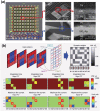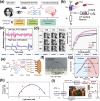Emerging memristive neurons for neuromorphic computing and sensing
- PMID: 37090846
- PMCID: PMC10120469
- DOI: 10.1080/14686996.2023.2188878
Emerging memristive neurons for neuromorphic computing and sensing
Abstract
Inspired by the principles of the biological nervous system, neuromorphic engineering has brought a promising alternative approach to intelligence computing with high energy efficiency and low consumption. As pivotal components of neuromorphic system, artificial spiking neurons are powerful information processing units and can achieve highly complex nonlinear computations. By leveraging the switching dynamic characteristics of memristive device, memristive neurons show rich spiking behaviors with simple circuit. This report reviews the memristive neurons and their applications in neuromorphic sensing and computing systems. The switching mechanisms that endow memristive devices with rich dynamics and nonlinearity are highlighted, and subsequently various nonlinear spiking neuron behaviors emulated in these memristive devices are reviewed. Then, recent development is introduced on neuromorphic system with memristive neurons for sensing and computing. Finally, we discuss challenges and outlooks of the memristive neurons toward high-performance neuromorphic hardware systems and provide an insightful perspective for the development of interactive neuromorphic electronic systems.
Keywords: Memristive devices; artificial neurons; neuromorphic computing; neuromorphic sensing; spiking dynamics.
© 2023 The Author(s). Published by National Institute for Materials Science in partnership with Taylor & Francis Group.
Conflict of interest statement
No potential conflict of interest was reported by the author(s).
Figures












Similar articles
-
Emerging Memristive Artificial Synapses and Neurons for Energy-Efficient Neuromorphic Computing.Adv Mater. 2020 Dec;32(51):e2004659. doi: 10.1002/adma.202004659. Epub 2020 Oct 1. Adv Mater. 2020. PMID: 33006204 Review.
-
Nonlinearity in Memristors for Neuromorphic Dynamic Systems.Small Sci. 2021 Sep 28;2(1):2100049. doi: 10.1002/smsc.202100049. eCollection 2022 Jan. Small Sci. 2021. PMID: 40212323 Free PMC article.
-
Stimuli-Responsive Memristive Materials for Artificial Synapses and Neuromorphic Computing.Adv Mater. 2021 Nov;33(46):e2006469. doi: 10.1002/adma.202006469. Epub 2021 Apr 9. Adv Mater. 2021. PMID: 33837601 Review.
-
Memristive and CMOS Devices for Neuromorphic Computing.Materials (Basel). 2020 Jan 1;13(1):166. doi: 10.3390/ma13010166. Materials (Basel). 2020. PMID: 31906325 Free PMC article. Review.
-
Electrolyte Gated Transistors for Brain Inspired Neuromorphic Computing and Perception Applications: A Review.Nanomaterials (Basel). 2025 Feb 24;15(5):348. doi: 10.3390/nano15050348. Nanomaterials (Basel). 2025. PMID: 40072151 Free PMC article. Review.
Cited by
-
Neuromorphic algorithms for brain implants: a review.Front Neurosci. 2025 Apr 11;19:1570104. doi: 10.3389/fnins.2025.1570104. eCollection 2025. Front Neurosci. 2025. PMID: 40292025 Free PMC article. Review.
-
From Brain Models to Robotic Embodied Cognition: How Does Biological Plausibility Inform Neuromorphic Systems?Brain Sci. 2023 Sep 13;13(9):1316. doi: 10.3390/brainsci13091316. Brain Sci. 2023. PMID: 37759917 Free PMC article. Review.
-
Understanding the Resistive Switching Behaviors of Top Electrode (Au, Cu, and Al)-Dependent TiO2-Based Memristive Devices.ACS Omega. 2024 May 26;9(23):24601-24609. doi: 10.1021/acsomega.4c00320. eCollection 2024 Jun 11. ACS Omega. 2024. PMID: 38882132 Free PMC article.
-
Memristor Emulator Circuits: Recent Advances in Design Methodologies, Healthcare Applications, and Future Prospects.Micromachines (Basel). 2025 Jul 17;16(7):818. doi: 10.3390/mi16070818. Micromachines (Basel). 2025. PMID: 40731727 Free PMC article. Review.
-
Interfacial Resistive Switching of Niobium-Titanium Anodic Memristors with Self-Rectifying Capabilities.Nanomaterials (Basel). 2024 Feb 19;14(4):381. doi: 10.3390/nano14040381. Nanomaterials (Basel). 2024. PMID: 38392754 Free PMC article.
References
-
- Silver D, Huang A, Maddison CJ, et al. Mastering the game of go with deep neural networks and tree search. Nature. 2016;529(7587):484–489. - PubMed
-
- Lu H, Li Y, Chen M, et al. Brain intelligence: go beyond artificial intelligence. Mob Netw Appl. 2018;23(2):368–375.
-
- Sundaram S, Kellnhofer P, Li Y, et al. Learning the signatures of the human grasp using a scalable tactile glove. Nature. 2019;569(7758):698–702. - PubMed
-
- Mehonic A, Kenyon AJ.. Brain-inspired computing needs a master plan. Nature. 2022;604(7905):255–260. - PubMed
Publication types
LinkOut - more resources
Full Text Sources
Research Materials
